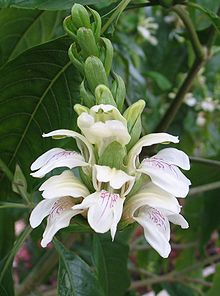Justicia adhatoda
| Justicia adhatoda | |
|---|---|

| |
| Scientific classification | |
| Kingdom: | Plantae |
| Clade: | Tracheophytes |
| Clade: | Angiosperms |
| Clade: | Eudicots |
| Clade: | Asterids |
| Order: | Lamiales |
| Family: | Acanthaceae |
| Genus: | Justicia |
| Species: | J. adhatoda
|
| Binomial name | |
| Justicia adhatoda | |
| Synonyms[2] | |
| |
Justicia adhatoda commonly known in English as Malabar nut, adulsa, adhatoda, vasa, vasaka,[3][4] is native to Asia.[5] Adathoda means 'untouched by goats' in Tamil. The name derives from the fact that animals like goats do not eat this plant due to its extreme bitter taste.[citation needed]
The plant's native range is Afghanistan, the Indian subcontinent (Bangladesh, India, Pakistan, Nepal and Sri Lanka), Laos, Myanmar and Vietnam. It has been introduced elsewhere.[6]
It is used as a traditional medicinal plant.[7]
Description
[edit]Justicia adhatoda is a shrub with 10-20 lance-shaped leaves 8-9 centimeters in length by four wide. They are oppositely arranged, smooth-edged, and borne on short petioles.[citation needed] When dry they are of a dull brownish-green colour. They are bitter-tasting. When a leaf is cleared with chloral hydrate and examined microscopically the oval stomata can be seen. They are surrounded by two crescent-shaped cells at right angles to the ostiole. The epidermis bears simple one- to three-celled warty hairs, and small glandular hairs. Cystoliths occur beneath the epidermis of the underside of the blade.[8]
The trunk has many long opposite ascending branches, where the bark is yellowish in color. Flowers are usually white and the inflorescence shows large, dense, axillary spikes. Fruits are pubescent, and are with club-shaped capsules.
Chemical composition
[edit]The leaves of Justicia adhatoda contains phytochemicals such as alkaloids, tannins, saponins, phenolics and flavonoids.[citation needed] The most important is vasicine, a quinazoline alkaloid.[5] The vasicine yield of the herbage has been measured as 0.541 to 1.1% by dry weight. Bromhexine, a serine protease inhibitor with mucolytic properties available over-the-counter in Europe, was developed from research on Justicia adhatoda.[9]
References
[edit]- ^ Plummer, J. (2021). "Justicia adhatoda". IUCN Red List of Threatened Species. 2021: e.T169274250A169300314. Retrieved 14 May 2022.
- ^ "Justicia adhatoda L." Plants of the World Online. Royal Botanic Gardens, Kew. Retrieved 2024-10-25.
- ^ "Common Names for Malabar Nut (Justicia adhatoda)". Encyclopedia of Life. Retrieved 3 January 2013.
- ^ Aslam, Mohd; Rais, Sumbul; Alam, Masood; Pugazhendi, Arulazhagan (2013). "Adsorption of Hg(II) from Aqueous Solution Using Adulsa (Justicia adhatoda) Leaves Powder: Kinetic and Equilibrium Studies". Journal of Chemistry. 2013: 1–11. doi:10.1155/2013/174807. ISSN 2090-9063.
- ^ a b "Facts about for Malabar Nut which are not known (Justicia adhatoda)". Encyclopedia of Life. Retrieved 3 January 2013.
- ^ "Justicia adhatoda L." Plants of the World Online. Royal Botanic Gardens, Kew. Retrieved 2022-06-16.
- ^ M Iqbal Zuberi (2012). "Flora". In Sirajul Islam; Miah, Sajahan; Khanam, Mahfuza; Ahmed, Sabbir (eds.). Banglapedia: the National Encyclopedia of Bangladesh (Online ed.). Dhaka, Bangladesh: Banglapedia Trust, Asiatic Society of Bangladesh. ISBN 984-32-0576-6. OCLC 52727562. OL 30677644M. Retrieved 16 November 2024.
- ^ Kumar, M., Dandapat, S., Kumar, A. and Sinha, M.P. Anti-typhoid activity of Adhatoda vasica and Vitex negundo Persian Gulf Crop Protection, 2013; 2(3): 64-75 http://corpprotection.ir/files_site/paperlist/Journal2-3-130906213336.pdf Archived 2015-05-29 at the Wayback Machine
- ^ Zanasi, Alessandro; Mazzolini, Massimiliano; Kantar, Ahmad (2017). "A reappraisal of the mucoactive activity and clinical efficacy of bromhexine". Multidisciplinary Respiratory Medicine. 12: 7. doi:10.1186/s40248-017-0088-1. PMC 5359817. PMID 28331610.

